A Semi-Analytical Model for the Heat Generation during Hybrid Metal Extrusion and Bonding (HYB)
Abstract
1. Introduction
2. How the HYB Process Control System Works
3. Components of the HYB Heat Generation Model
3.1. Heat Flow Model
3.2. Frictional Heating Model
3.3. Coupling of Models
4. Materials and Experimental Conditions
5. Results and Discussion
6. Conclusions
Author Contributions
Funding
Informed Consent Statement
Data Availability Statement
Acknowledgments
Conflicts of Interest
Appendix A
| Symbol | Description |
|---|---|
| Thermal Diffusivity, m2/s | |
| surface area, m2 | |
| specific heat capacity, J/(kg °C) | |
| plate thickness, m | |
| gross heat input during extrusion and joining, J/m | |
| distance, as defined in Figure 4, m | |
| distance, as defined in Figure 4, m | |
| groove width, m | |
| Bessel function of the second kind and zero order | |
| filler metal flow rate, kg/s | |
| torque acting on drive spindle, Nm | |
| spindle rotational speed, RPM | |
| net power input due to frictional heating and plastic deformation, W | |
| contribution from to the filler metal additions to the net heat generation, W | |
| contribution from the rotating pin shoulder to the net heat generation, W | |
| contribution from the rotating pin tip to the net heat generation, W | |
| radial distance from centre of heat source, m552 | |
| pin shoulder radius, m | |
| tip radius, m | |
| fixed value for r in heat generation model, m | |
| t | time, s |
| temperature, °C | |
| initial temperature, °C | |
| eutectic temperature of alloy, °C | |
| filler metal temperature, °C | |
| aluminium–tool interface temperature, °C | |
| welding speed, m/s | |
| heat per unit time removed from the extruder by the CO2-coolant, W | |
| gross power input during extrusion and joining, W | |
| total power consumption during extrusion and joining, W | |
| welding direction, m | |
| thermal conductivity, W/(m °C) | |
| density, kg/m3 | |
| thermal efficiency factor | |
| angular rotation speed, rad/s | |
| local yield shear stress, Pa | |
| friction shear stress, Pa | |
| local aluminium yield strength in shear, Pa | |
| upper threshold value for , Pa | |
| correction term, as calculated from Equation (7), rad | |
| correction term, as calculated from Equation (10), rad |
Appendix B
| (MPa) | (° C), pos. 3 mm | Err% | (° C), pos. 4 mm | Err% | ||
|---|---|---|---|---|---|---|
| Predictions | Experiments | Predictions | Experiments | |||
| 69 | 380.9 | 395.4 | −3.7 | 343.8 | 344,2 | −0.12 |
| 64 | 367.3 | 395.4 | −7.1 | 332 | 344.2 | −3.54 |
| 58 | 352 | 395.4 | −11.0 | 319 | 344.2 | −7.32 |
| 75 | 390.1 | 395.4 | −1.3 | 353.1 | 344.2 | 2.59 |
| (mm) | (mm) | (° C) pos. 3 mm | (° C) pos. 4 mm |
|---|---|---|---|
| 2.75 | 5.5 | 380.9 | 343.8 |
| 2.5 | 5.5 | 374.4 | 337.3 |
| 2.75 | 5.25 | 366.5 | 330.9 |
| 3 | 5.5 | 388.1 | 351.4 |
| 2.75 | 5.75 | 391.9 | 353.7 |
| 2.5 | 5.25 | 358.9 | 324.1 |
References
- American Welding Society. Welding Processes. In AMS Welding Handbook; American Welding Society: Miami, FL, USA, 2007; Volume 3. [Google Scholar]
- ASM Handbook Welding, Brazing and Soldering; ASM International: Materials Park, OH, USA, 1993; Volume 6, p. 254.
- Grong, Ø. Recent Advances in Solid-State Joining of Aluminium. Weld. J. 2012, 91, 26–33. [Google Scholar]
- Grong, Ø. Metallurgical Modelling of Welding, 2nd ed.; The Institute of Materials: London, UK, 1997. [Google Scholar]
- Nandan, R.; DebRoy, T.; Bhadeshia, H.K.D.H. Recent advances in friction-stir welding—Process, weldment structure and properties. Prog. Mater. Sci. 2008, 53, 980–1023. [Google Scholar] [CrossRef]
- Lim, S.; Kim, S.; Lee, C.-G.; Kim, S. Tensile Behavior of Friction Stir-Welded AZ31-H24 Mg Alloy. Metall. Mater. Trans. A 2005, 36A, 1609–1612. [Google Scholar] [CrossRef]
- Uematsu, Y.; Tozaki, Y.; Tokaji, K.; Nakamura, M. Fatigue behavior of dissimilar friction stir welds between cast and wrought aluminum alloys. Strength Mater. 2008, 40, 138–141. [Google Scholar] [CrossRef]
- Storjohann, D.; Barabash, O.M.; Babu, S.S.; David, S.A.; Sklad, P.S.; Bloom, E.E. Fusion and friction stir welding of aluminum-metal-matrix composites. Metall. Mater. Trans. A 2005, 36A, 3237–3247. [Google Scholar] [CrossRef]
- Cavaliere, P.; Cerri, E.; Marzioli, L.; Dos Santos, J. Friction Stir Welding of Ceramic Particle Reinforced Aluminium Based Metal Matrix Composites. J. Appl. Comp. Mater. 2004, 11, 246–258. [Google Scholar]
- Grong, Ø.; Sandnes, L.; Berto, F. A Status Report on the Hybrid Metal Extrusion & Bonding (HYB) Process and Its Applications. Mater. Des. Process. Commun. 2019, 1, 41. [Google Scholar]
- Grong, Ø.; Sandnes, L.; Berto, F. Progress in Solid State Joining of Metals and Alloys. Procedia Struct. Integr. 2019, 17, 788–798. [Google Scholar] [CrossRef]
- Leoni, F.; Grong, Ø.; Ferro, P.; Berto, F. Simulating the dependence of the filler wire feeding on the wire size in the hybrid metal extrusion & bonding (HYB) process. Procedia Struct. Integr. 2020, 26, 321–329. [Google Scholar]
- Leoni, F.; Grong, Ø.; Sandnes, L.; Berto, F. High temperature tensile properties of AA6082 filler wire used for solid-state joining. Procedia Struct. Integr. 2020, 25, 348–354. [Google Scholar] [CrossRef]
- Leoni, F.; Grong, Ø.; Sandnes, L.; Welo, T.; Berto, F. Finite element modelling of the filler wire feeding in the hybrid metal extrusion & bonding (HYB) process. J. Adv. Join. Process. 2020, 1, 100006. [Google Scholar]
- Dong, P.; Lu, F.; Hong, J.K.; Cao, Z. Coupled thermomechanical analysis of friction stir welding process using simplified models. Sci. Technol. Weld. Join. 2001, 6, 281–287. [Google Scholar] [CrossRef]
- Ulysse, P. Three-dimensional modeling of the friction stir-welding process. Mach. Tools Manuf. 2002, 42, 1549–1557. [Google Scholar] [CrossRef]
- Colegrove, P.A.; Shercliff, H.R. Development of Trivex friction stir welding tool Part 2—Three-dimensional flow modelling. Sci. Technol. Weld. Join. 2004, 9, 352–361. [Google Scholar] [CrossRef]
- Schmidt, H.; Hattel, J. A local model for the thermomechanical conditions in friction stir welding. Model. Simul. Mater. Sci. Eng. 2005, 13, 77–93. [Google Scholar] [CrossRef]
- Fourment, L.; Guerdoux, S. 3D numerical simulation of the three stages of Friction Stir Welding based on friction parameters calibration. Int. J. Mater. Form. Suppl. 2008, 1, 1287–1290. [Google Scholar] [CrossRef]
- Chao, Y.J.; Qi, X.; Tang, W. Heat Transfer in Friction Stir Welding—Experimental and Numerical Studies. J. Manuf. Sci. Eng. 2003, 125, 138–145. [Google Scholar] [CrossRef]
- Zhu, X.K.; Chao, Y.J. Numerical simulation of transient temperature and residual stresses in friction stir welding of 304L stainless steel. J. Mater. Process. Technol. 2004, 146, 263–272. [Google Scholar] [CrossRef]
- Khandkar, M.Z.H.; Khan, J.A.; Reynolds, A.P. Prediction of temperature distribution and thermal history during friction stir welding: Input torque based model. Sci. Technol. Weld. Join. 2003, 8, 165–174. [Google Scholar] [CrossRef]
- Schmidt, H.; Hattel, J.; Wert, J. An analytical model for the heat generation in friction stir welding. Model. Simul. Mater. Sci. Eng. 2004, 12, 143–157. [Google Scholar] [CrossRef]
- Leoni, F.; Grong, Ø.; Fjær, H.G.; Ferro, P.; Berto, F. A First Approach on Modelling the Thermal and Microstructure Fields During Aluminium Butt Welding Using the HYB PinPoint Extruder. Procedia Struct. Integr. 2020, 28, 2253–2260. [Google Scholar] [CrossRef]
- Ferro, P.; Bonollo, F. A Semianalytical Thermal Model for Friction Stir Welding. Metall. Mater. Trans. A 2010, 41A, 440–449. [Google Scholar] [CrossRef]
- Rosenthal, D. Mathematical Theory of Heat Distribution during Welding and Cutting. Weld. J. 1941, 20, 220–234. [Google Scholar]
- Rosenthal, D.; Shamerber, H. Thermal study of arc welding. Weld. J. 1938, 17, 2–8. [Google Scholar]
- Schmidt, H.B.; Hattel, J.H. Thermal modelling of friction stir welding. Scr. Mater. 2008, 58, 332–337. [Google Scholar] [CrossRef]
- Leoni, F.; Sandnes, L.; Grong, Ø.; Berto, F. Mechanical behavior of gas metal arc AA6082-T6 weldments. Procedia Struct. Integr. 2019, 18, 449–456. [Google Scholar] [CrossRef]
- Essa, A.R.S.; Ahmed, M.M.Z.; Mohamed, A.-Y.A.; El-Nikhaily, A.E. An analytical model of heat generation for eccentric cylindrical pin in friction stir welding. J. Mater. Res. Technol. 2016, 5, 234–240. [Google Scholar] [CrossRef]
- Jacquin, D.; de Meester, B.; Simar, A.; Deloison, D.; Montheillet, F.; Desrayaud, C. A simple Eulerian thermomechanical modeling of friction stir welding. J. Mater. Process. Technol. 2011, 211, 57–65. [Google Scholar] [CrossRef]
- Kaid, M.; Zemri, M.; Brahami, A.; Zahaf, S. Effect of friction stir welding (FSW) parameters on the peak temperature and the residual stresses of aluminum alloy 6061-T6: Numerical modelisation. Int. J. Interact. Des. Manuf. 2019, 13, 797–807. [Google Scholar] [CrossRef]
- Vaira Vignesh, R.; Padmanaban, R.; Arivarasu, M.; Thirumalini, S.; Gokulachandran, J.; Sesha Satya Sai Ram, M. Numerical modelling of thermal phenomenon in friction stir welding of aluminum plates. IOP Conf. Ser. Mater. Sci. Eng. 2016, 149, 012208. [Google Scholar] [CrossRef]

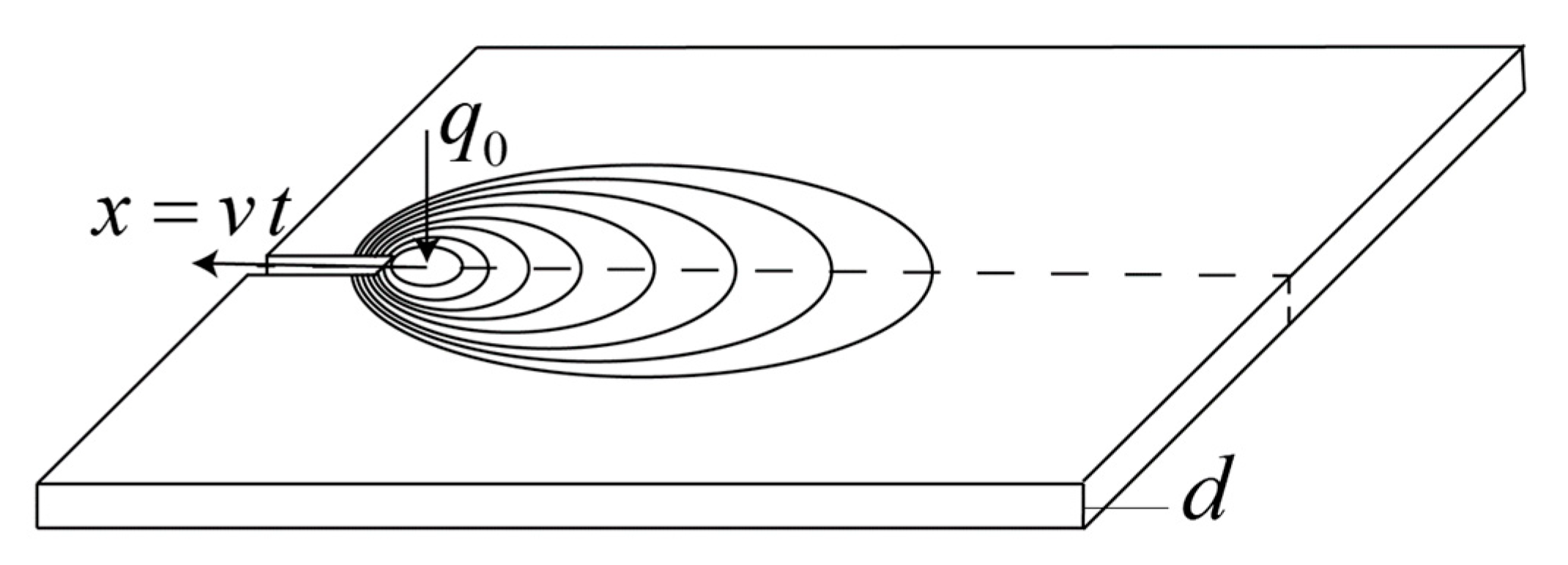
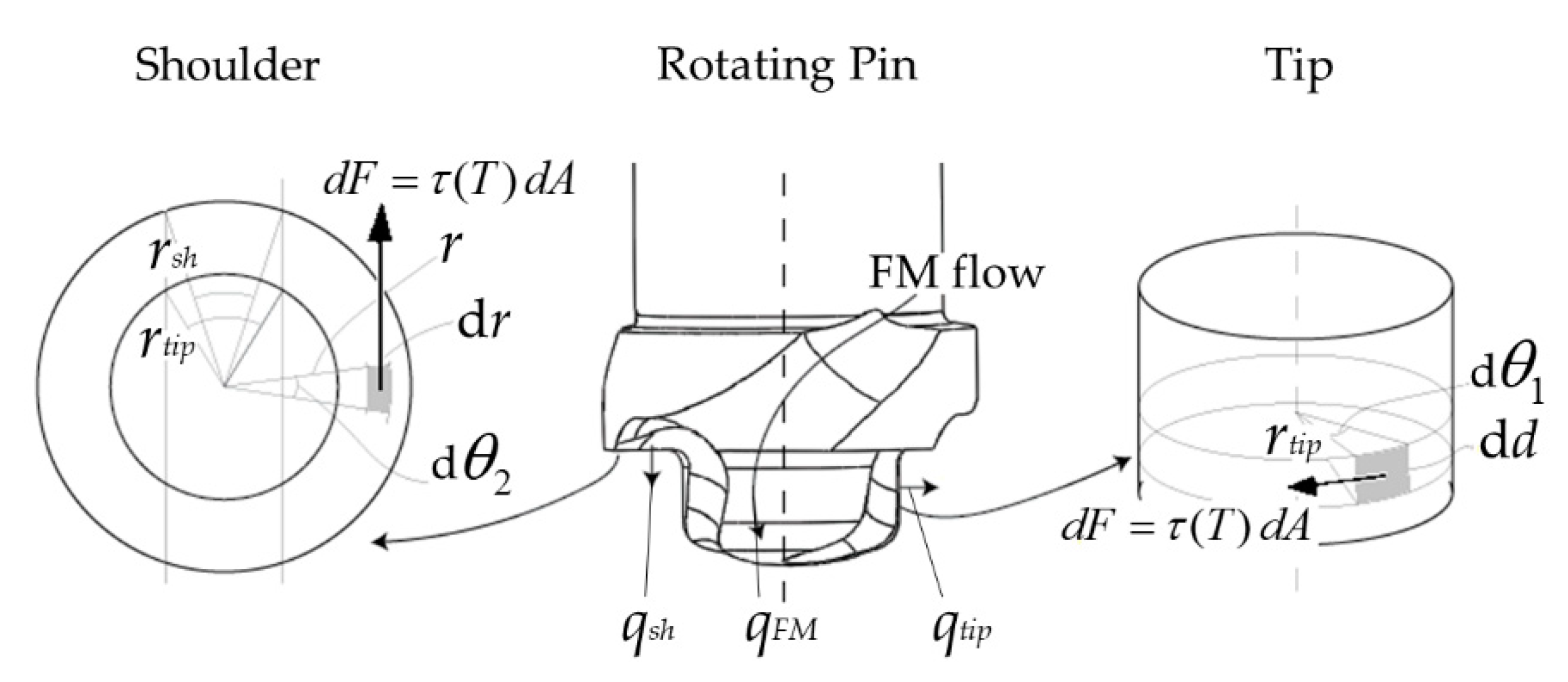
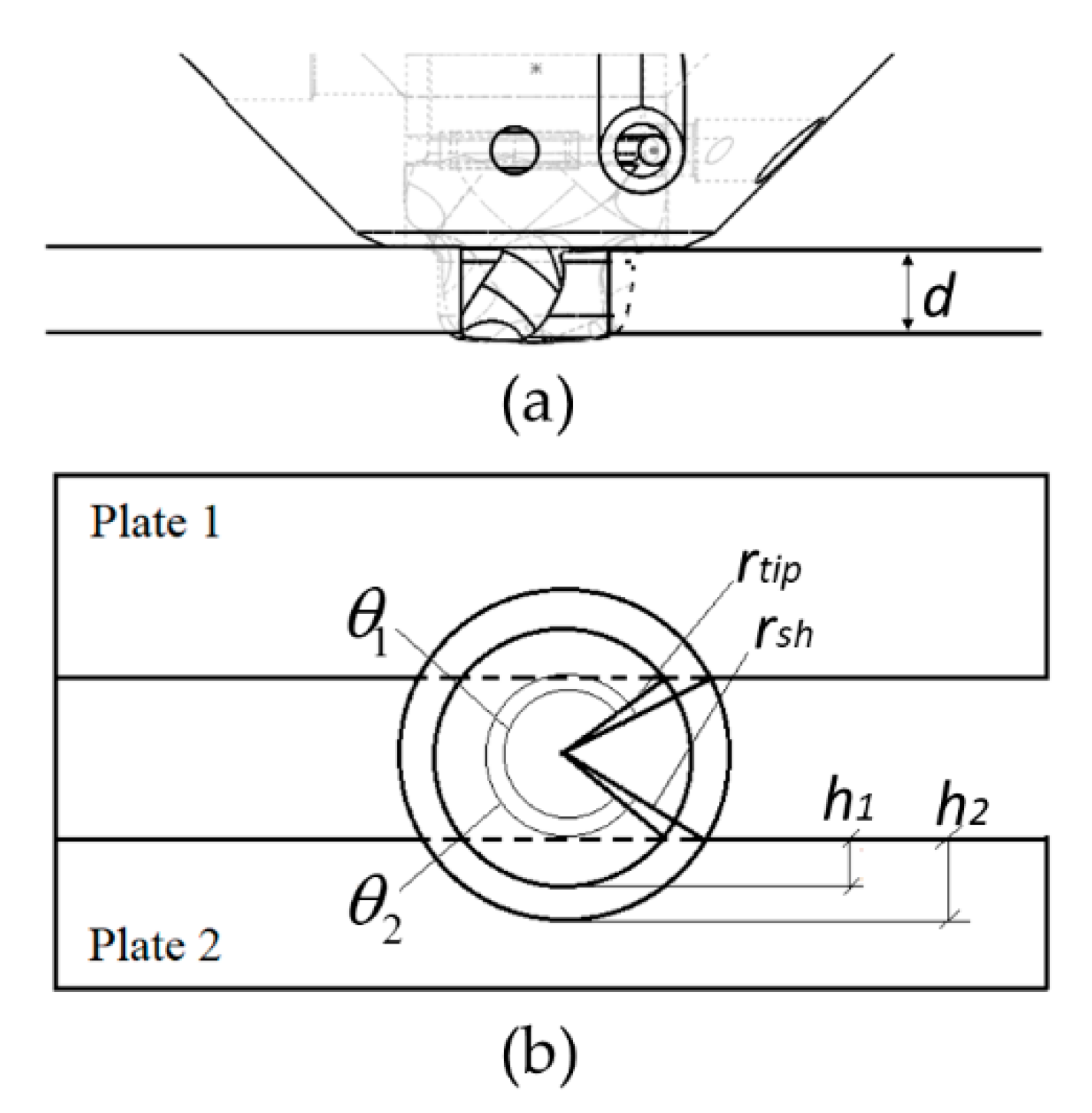



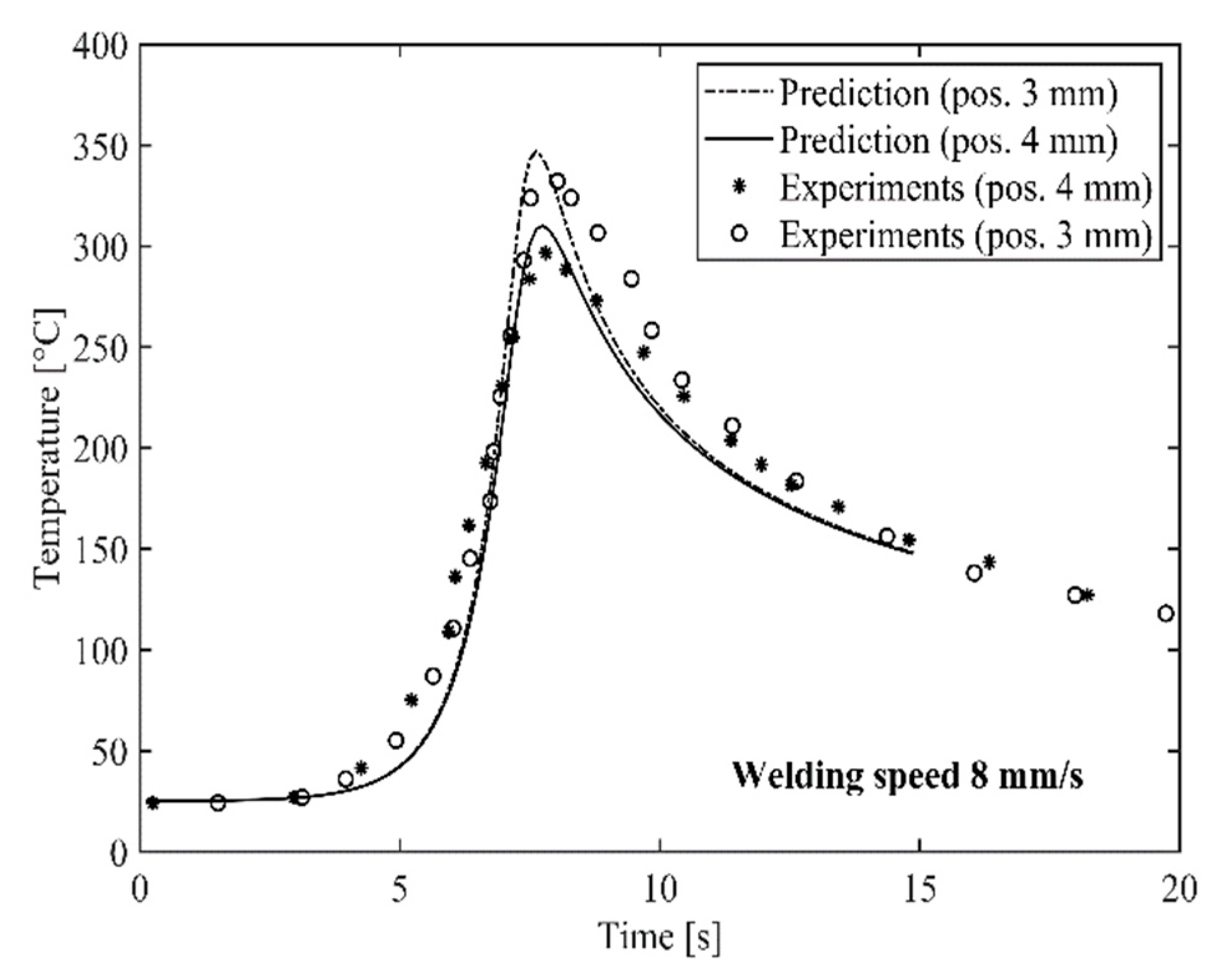

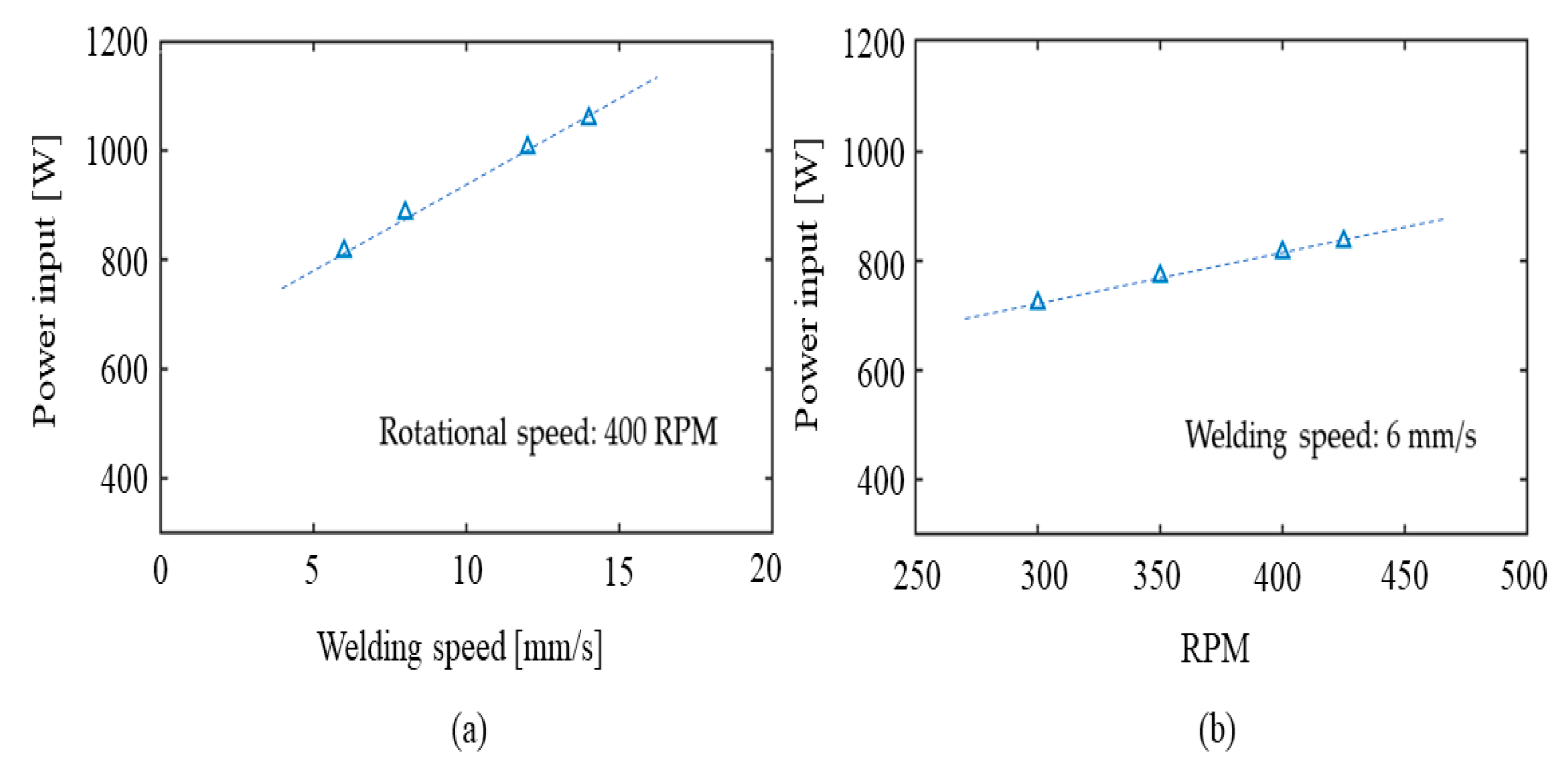
| Symbol | Value | Units | Source |
|---|---|---|---|
| 2700 | kg/m3 | [4] | |
| 896 | J/(kg°C) | [4] | |
| 167 | W/(m°C) | [4] | |
| m2/s | [4] | ||
| m | - | ||
| 25 | °C | - | |
| Pa | [29] | ||
| 42 | rad/s | - | |
| m | - | ||
| m | - | ||
| m | - | ||
| 583 | °C | [4] | |
| kg/s | - | ||
| 450 | °C | [14] |
| I-Groove Width | Welding Speed | Pin Rotational Speed | Wire Feed Rate | Gross Power Output † |
|---|---|---|---|---|
| 3 mm | 6 and 8 mm/s | 400 RPM | 142 mm/s | 3135 W |
| Welding Speed | Pin Rotational Speed | Net Power Input | Thermal Efficiency Factor |
|---|---|---|---|
| 6 mm/s | 400 RPM | 823 W | 0.26 |
| 8 mm/s | 400 RPM | 844 W | 0.27 |
Publisher’s Note: MDPI stays neutral with regard to jurisdictional claims in published maps and institutional affiliations. |
© 2020 by the authors. Licensee MDPI, Basel, Switzerland. This article is an open access article distributed under the terms and conditions of the Creative Commons Attribution (CC BY) license (http://creativecommons.org/licenses/by/4.0/).
Share and Cite
Leoni, F.; Grong, Ø.; Ferro, P.; Berto, F. A Semi-Analytical Model for the Heat Generation during Hybrid Metal Extrusion and Bonding (HYB). Materials 2021, 14, 170. https://doi.org/10.3390/ma14010170
Leoni F, Grong Ø, Ferro P, Berto F. A Semi-Analytical Model for the Heat Generation during Hybrid Metal Extrusion and Bonding (HYB). Materials. 2021; 14(1):170. https://doi.org/10.3390/ma14010170
Chicago/Turabian StyleLeoni, Francesco, Øystein Grong, Paolo Ferro, and Filippo Berto. 2021. "A Semi-Analytical Model for the Heat Generation during Hybrid Metal Extrusion and Bonding (HYB)" Materials 14, no. 1: 170. https://doi.org/10.3390/ma14010170
APA StyleLeoni, F., Grong, Ø., Ferro, P., & Berto, F. (2021). A Semi-Analytical Model for the Heat Generation during Hybrid Metal Extrusion and Bonding (HYB). Materials, 14(1), 170. https://doi.org/10.3390/ma14010170







